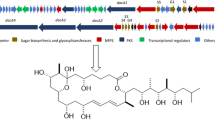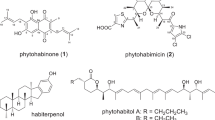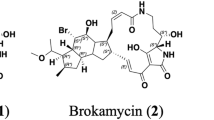Abstract
New three macrocyclic diolides, named bispolides C-E (1–3), were isolated from a fermentation broth of the actinomycete strain MG372-hF19, which produces an indole glycoside and leptomycins as we reported previously. The absolute structures of compounds 1–3 were elucidated by NMR and X-ray crystallography. Compounds 1–3 diverge from the known nine bispolides in their different alkylation patterns on the 20-membered macrocyclic diolide skeleton and the side chain in their planar structures. Furthermore, compounds 1–3 exhibited antibacterial activity against methicillin-resistant Staphylococcus aureus and vancomycin-resistant Enterococci and cytotoxic activity against human cancer cell lines. Among them, compound 3 has the most potent biological activities against bacteria and tumor cells. Additionally, using a membrane-potential-sensitive fluorescence probe, we found that compounds 1–3 and elaiophylin have a similar effect on membrane potential in A549 human lung cancer cells.
This is a preview of subscription content, access via your institution
Access options
Subscribe to this journal
Receive 12 print issues and online access
$259.00 per year
only $21.58 per issue
Buy this article
- Purchase on Springer Link
- Instant access to full article PDF
Prices may be subject to local taxes which are calculated during checkout





Similar content being viewed by others

References
Gazdar AF, Bunn PA, Minna JD. Small-cell lung cancer: what we know, what we need to know and the path forward. Nat Rev Cancer. 2017;17:725–37.
Bunn PA Jr, Minna JD, Augustyn A, Gazdar AF, Ouadah Y, Krasnow MA, et al. Small cell lung cancer: can recent advances in biology and molecular biology be translated into improved outcomes? J Thorac Oncol 2016;11:453–74.
Arcamone FM, Bertazzoli C, Ghione M, Scotti TG. Melanosporin and elaiophylin, new antibiotics from Streptomyces melanosporus (sive melonsporofaciens) n. sp. Gion. Microbial. 1959;7:207–16.
Arai M. Azalomycins B and F, two new antibiotics. I. Production and isolation. J Antibiot. 1960;13:46–50.
Zhao X, Fang Y, Yang Y, Qin Y, Wu P, Wang T, et al. Elaiophylin, a novel autophagy inhibitor, exerts anti-tumor activity as a single agent in ovarian cancer cells. Autophagy. 2015;11:1849–63.
Okujo N, Iinuma H, George A, Eim KS, Li TL, Ting NS, et al. Bispolides, Novel 20-Membered Ring Macrodiolide Antibiotics from Microbispora. J Antibiot. 2007;60:216–9.
Otoguro K, Iwatsuki M, Ishiyama A, Namatame M, Nishihara-Tsukashima A, Sato S, et al. In vitro and in vivo antiprotozoal activities of bispolides and their derivatives. J Antibiot. 2010;63:275–7.
Kohda Y, Sakamoto S, Otsuka Y, Sawa R, Kubota Y, Igarashi M, et al. A new indole glycoside from Kitasatospora sp. MG372-hF19 carrying a 6-deoxy-α-L-talopyranose moiety. J Antibiot. 2020;73:167–70.
Clinical and Laboratory Standards Institute (CLSI). Methods for dilution antimicrobial susceptibility tests for bacteria that grow aerobically; Approved Standard, 8th ed. M7-A8; Wayne, PA, USA: CLSI; 2009.
Dan S, Tsunoda T, Kitahara O, Yanagawa R, Zembutsu H, Katagiri T, et al. An integrated database of chemosensitivity to 55 anticancer drugs and gene expression profiles of 39 human cancer cell lines. Cancer Res. 2002;62:1139–47.
Kong D, Yamori T. JFCR39, a panel of 39 human cancer cell lines, and its application in the discovery and development of anticancer drugs. Bioorg Med Chem. 2012;20:1947–51.
Wu C, Tan Y, Gan M, Wang Y, Guan Y, Hu X, et al. Identification of elaiophylin derivatives from the marine-derived actinomycete Streptomyces sp. 7-145 using PCR-based screening. J Nat Prod. 2013;76:2153–7.
Gui M, Zhang M, Wu W, Sun P. Natural occurrence, bioactivity and biosynthesis of elaiophylin analogues. Molecules. 2019;24:3840.
Williams JD, Sefton AM. Comparison of macrolide antibiotics. J Antimicrob Chemother. 1993;31 Suppl. C:11–26.
Wang G, Zhou P, Chen X, Zhao L, Tan J, Yang Y, et al. The novel autophagy inhibitor elaiophylin exerts anti-tumor activity against multiple myeloma with mutant TP53 in part through endoplasmic reticulum stress-induced apoptosis. Cancer Biol Ther. 2017;18:584–95.
Grigoriev PA, Schlegel R, Grafe U. Cation selective ion channels formed by macrodiolide antibiotic elaiophylin in lipid bilayer membranes. Bioelectrochemistry. 2001;54:11–5.
Papini E, Sandona D, Rappuoli R, Montecucco C. On the membrane translocation of diphtheria toxin: at low pH the toxin induces ion channels on cells. EMBO J. 1988;7:3353–9.
Katayama H, Kusaka Y, Yokota H, Akao T, Kojima M, Nakamura O, et al. Parasporin-1, a novel cytotoxic protein from Bacillus thuringiensis, induces Ca2+ influx and a sustained elevation of the cytoplasmic Ca2+ concentration in toxin-sensitive cells. J Biol Chem. 2007;282:7742–52.
Acknowledgements
The authors thank Dr. I. Momose and Mr. S. Ohba for technical assistance and discussion. The authors also thank the Molecular Profiling Committee, Grant-in-Aid for Scientific Research on Innovative Areas “Advanced Animal Model Support (AdAMS)” from The Ministry of Education, Culture, Sports, Science and Technology, Japan (JSPS KAKENHI Grant Number JP 16H06276). This work was supported in part by grants from JSPS KAKENHI Grant Number 17K08777.
Author information
Authors and Affiliations
Corresponding authors
Ethics declarations
Conflict of interest
The authors declare no competing interests.
Additional information
Publisher’s note Springer Nature remains neutral with regard to jurisdictional claims in published maps and institutional affiliations.
Supplementary information
Rights and permissions
About this article
Cite this article
Kohda, Y., Sakamoto, S., Umekita, M. et al. Isolation of new derivatives of the 20-membered macrodiolide bispolide from Kitasatospora sp. MG372-hF19. J Antibiot 75, 77–85 (2022). https://doi.org/10.1038/s41429-021-00492-5
Received:
Revised:
Accepted:
Published:
Issue Date:
DOI: https://doi.org/10.1038/s41429-021-00492-5


